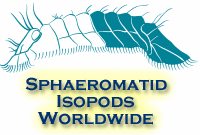| Abstract |
The isopod Sphaeroma terebrans Bate, 1866 burrows in aerial roots of the red mangrove Rhizophora mangle L. The burrows serve as shelter and as a reproductive habitat, and females are known to host their offspring in their burrows. I examined the reproductive biology of S. terebrans in the Indian River Lagoon, a shallow lagoon stretching for similar to 200 km along the Atlantic coast of Florida, USA. Reproductive isopods were found throughout the year, but reproductive activity was highest in the fall and during late spring/early summer. During the latter periods, large numbers of subadults established their own burrows in aerial roots. The average numbers of S. tereblans per root were high during the fall, but decreased during the winter and reached lowest levels at the end of the summer. Females reached maturity at a larger size than males, but also grew to larger sizes than the males. The average size of females varied between 8 and 10 mm, the average size of males between 6.5 and 8.5 mm. The number of embryos female(-1) was strongly correlated with female body length. No indication for embryo mortality during development was found. Parental females (i.e. with juveniles in their burrows) hosted on average between 5 and 20 juveniles in their burrows (range 1 to 59). Most juveniles found in female burrows were in the manca stage and 2 to 3 mm in body length. Juveniles did not increase in size while in the maternal burrow, and juveniles of similar sizes could also be found in their own burrows. Males did not participate in extended parental care, since most of them left the females after copulation. Many females that were born in the summer produced one brood in the fall and a second during winter/early spring. Females that were born in the fall produced one brood during spring/early summer, but then probably died. Extended parental care in S. terebrans is short compared to other peracarid crustaceans. It is concluded that this reproductive strategy in S. terebrans serves primarily to shelter small juveniles immediately after they emerge from the female body, when their exoskeleton is still hardening and their physiological capabilities are still developing. Thus, in S. terebrans, extended parental care probably aids to protect small juveniles from adverse physical conditions in their subtropical intertidal habitat. |

















